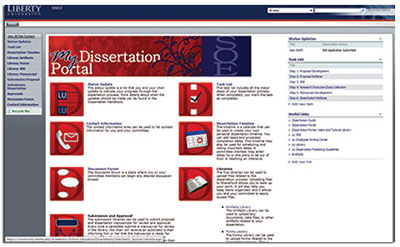Liberty University
|
Project: The Dissertation Portal
Project lead: Amanda Rockinson-Szapkiw, chair of doctoral research
Tech vendors/partners:
|
As Liberty University's (VA) online Ph.D. program in education has grown, so has the complexity of managing the paperwork involved in tracking dissertation progress. With the program serving more than 600 students at a time, traditional e-mail correspondence was failing to keep up.
"So much got lost in the shuffle," says Amanda Rockinson-Szapkiw, assistant professor of education and chair of doctoral research in the School of Education. "Documents and versions were hard to track." Files were sent as attachments, saved to desktops, and sometimes lost. "Really annoying was when faculty members would spend time commenting on an older version of a dissertation, only to find that the student had addressed some of those issues already," she says.

Liberty U's Dissertation Portal provides Ph.D. candidates with an individual secure site to post their progress and collaborate with their dissertation committee. |
Administrators at Liberty, which bills itself as the largest Christian university in the world, were also well aware of the higher attrition rates in online graduate programs. They wanted a clearer picture of which department chairs were working with which students and where they were in the process. There was no easy way to see that information in a single view.
In 2010, the education school's dean asked Rockinson-Szapkiw to study this problem and see if she could find an answer. "I started looking at technology solutions to help us increase retention rates, improve communication, and give us an administrative view of the dissertation process," she says. What they needed, she decided, was a collaborative workspace. She started looking at Google Docs and WordPress but thought they lacked critical functionality, such as strong security controls and integration with Microsoft Word, which most of the graduate students were using. "Then another faculty member reminded me that the university's existing campus agreement for Microsoft licensing already included SharePoint Server, although SharePoint hadn't been used for educational purposes yet at all. So I ran with it."
"Learned to run with it" might be a more apt description, since Rockinson-Szapkiw knew nothing about SharePoint and didn't want to wait until the next budgeting cycle when she could hire consultants. Sniffing around the university, she found expertise and help from a student employee and a few members of the university's faculty support group. Their day job is building courses in Blackboard, but they offered her some ideas on how to proceed. "I watched hours and hours of videos on Lynda.com about how to use SharePoint," she recalls, "and then built it from the ground up."
Rockinson-Szapkiw thought she was building a basic content management system, dubbed the Dissertation Portal. But, since its fall 2010 launch, when it housed documentation for the dissertation process, the portal has gradually developed into a shared workspace where Ph.D. candidates can collaborate with their peers. Each candidate now has an individual secure site to post his or her progress and collaborate with a dissertation committee. Users take advantage of discussion forums, document sharing, and multiple-person editing. Students post status updates that the administration aggregates to track progress of all students in the process. In addition, administrators get the dashboard view that they wanted, giving them more oversight of the process.
Since the portal's inception, Liberty has sought to measure its impact. The college surveyed students before and after implementation, using a "doctoral student connectedness scale" that was designed to identify students at risk of dropping out. Their research found that use of the portal increased doctoral candidates' connectedness by 9 percent as measured on the scale.
What's more, the dissertation approval process time has been cut in half. "Documents aren't sitting on one professor's computer waiting for that person to finish looking at it before handing it off to another," she says. "On the portal, any committee person can go in when they have time, in any order, to comment. That concurrent review saves lots of time."
Although the original goal was to improve workflow between candidates and faculty members, the collaborative nature of SharePoint is allowing the students to work together as they participate in discussion forums about topics such as research methodologies and how to do literature searches. A future goal is to create research teams in the portal that align with faculty expertise, so that students and faculty can naturally organize themselves around areas of common interest.
Melanie Dunn, a high school Spanish teacher in the Forsyth County, GA, school district, completed her Ph.D. at Liberty in 2012. "I found the organization within SharePoint most helpful," she says. "All the documents I needed for IRB [institutional review board] approval and proposal development and approval were right there. It's comforting to know that you and your chair are working on the same version," she adds. "And both parties get an e-mail notification when a change has been made to the document."
Dunn and her fellow students at Liberty may be on the ground floor of a wider collaborative dissertation community. Since Microsoft published a case study on the college's use of SharePoint in August 2011, several universities have asked Rockinson-Szapkiw for consulting help on replicating aspects of the system.
About the Author
David Raths is a Philadelphia-based freelance writer focused on information technology. He writes regularly for several IT publications, including Healthcare Innovation and Government Technology.